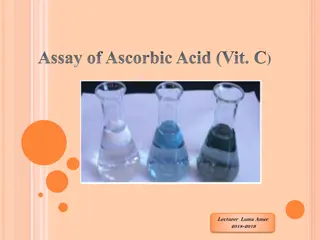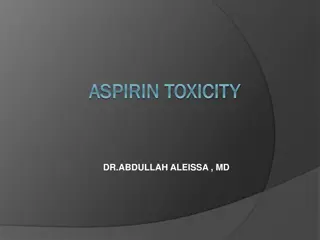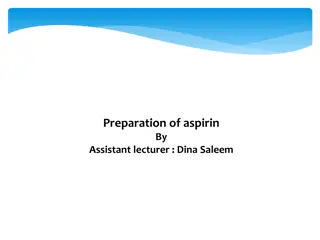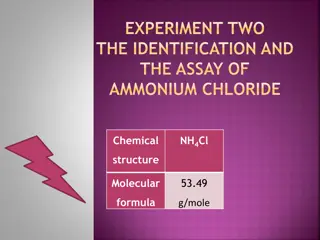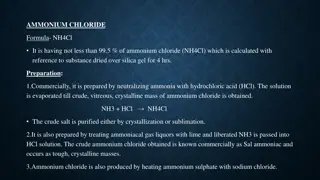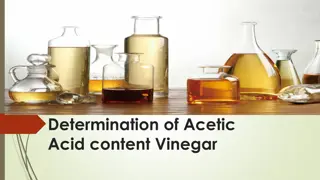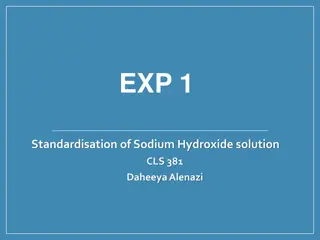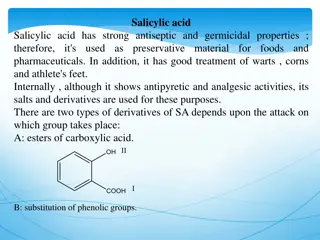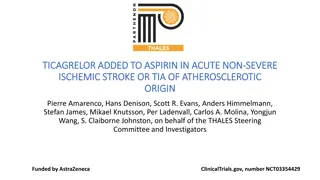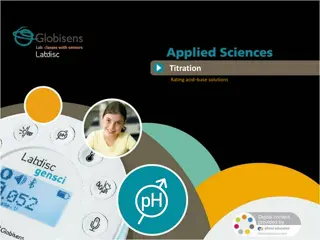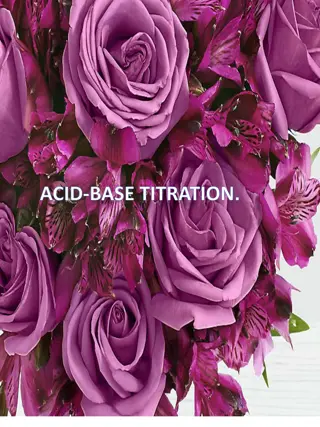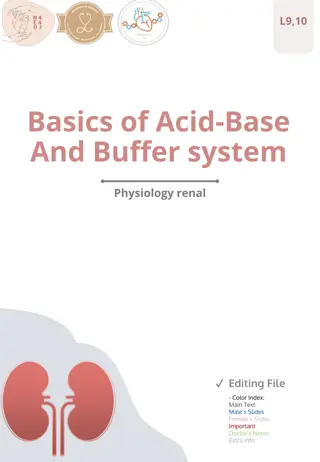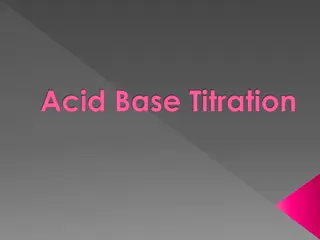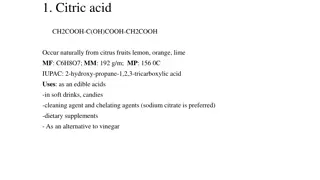Assay of Aspirin by Indirect Acid-Base Titration
Indirect titration, also known as residual titration, is an analytical technique used to determine the weight of an unknown sample by employing excess standard solution. In the case of aspirin, which is a weak acid undergoing slow hydrolysis, back titration with NaOH and HCl is utilized to overcome the challenge posed by the reaction with two hydroxide ions. The molecular weight of aspirin is 180.2 g/mole, and the procedure involves specific steps including crushing aspirin tablets, using ethanol, phenolphthalein, HCl, and NaOH to determine the amount of unreacted base. Important note emphasizes the need for using excess NaOH for complete titration.
Download Presentation

Please find below an Image/Link to download the presentation.
The content on the website is provided AS IS for your information and personal use only. It may not be sold, licensed, or shared on other websites without obtaining consent from the author.If you encounter any issues during the download, it is possible that the publisher has removed the file from their server.
You are allowed to download the files provided on this website for personal or commercial use, subject to the condition that they are used lawfully. All files are the property of their respective owners.
The content on the website is provided AS IS for your information and personal use only. It may not be sold, licensed, or shared on other websites without obtaining consent from the author.
E N D
Presentation Transcript
Assay of aspirin by Indirect acid- base titration Lecturer Luma Amer 2020-2021
Indirect titration (residual titration) Indirect titration is defined as the analytical technique that can be used to determine the weight of an unknown (sample) by using an excess amount of a standard solution. Indirect titration (residual titration) is used 1. The sample is volatile,e.g. NH3 . 2. The sample is insoluble salt , e.g. CaCO3. 3. Particular reaction is too slow. 4. It is difficult to determine the end point . 5. Substances which decompose on heating, e.g. , Formaldehyde.
Indirect titration ( residual titration) is a two stage analytical technique: 1. React the unknown ( sample) with an excess amount of the standard solution. 2. Determine the volume of the excess amount of the standard solution by using the direct titration with an another standard solution.
Determination of Aspirin using Back Titration Aspirin is a weak acid that also undergoes slow hydrolysis, , therefore aspirin molecule reacts with two hydroxide ions, how can you overcome this problem ? This problem is solved, by adding a known excess amount of the NaOH base to the sample solution and an HCl titration is carried out to determine the amount of unreacted base.
PROCEDURE: Crush 3 tablets (300) mg of aspirin 20 ml of ethanol? 3 drops phenolphthalein Swirl to dissolve 0.10N HCl 0.10N NaOH Cool for 5 mintsHeat for 15 mints? Avoid boiling? E.P. Cloudy white E.P. cloudy pink solution? Acidic medium basic medium V= 26+26+10 =62ml NaOH
Important Note The aspirin/NaOH acid-base reaction consumes one mole of hydroxide per mole of aspirin. The slow aspirin/NaOH hydrolysis reaction also consumes one mole of hydroxide per mole of aspirin, and so for a complete titration we will need to use a total of twice the amount of NaOH that you have already used, plus we will add some excess NaOH to ensure that we really have reacted with all of the aspirin in your sample (adding excess reactant drives the equilibrium towards products Le Chatelier s principle).
If the solution is colorless, add a few more drops of phenolphthalein. If it remains colorless, add 10 mL more of the base and reheat. (Don't forget to add this additional volume of base to the previously recorded total volume.) In back titration with acid The only base remaining in the flask will be excess base that has not reacted with the aspirin. Using your burette with your ~0.1 M HCl solution, titrate the excess base in the flask with HCl until the pink colour just disappears. The endpoint is best described as cloudy white .
DATA AND CALCULATION: 1. Calculate the total volume of NaOH? V NaOH = Vtotal V = 26+26+10=62 ml 2. Calculate the volume of HCl? VHCl =---- ml 3. Wt of aspirin = (VNaOH VHCl) x NNaOH x Eq.wt of aspirin 4. Recovery % = practical content / theoretical x 100 C9H8O4 + 2 NaOH C7H503Na + CH3COONa (ASA) Sodium Salicylate Sodium Acetate
Required Reading D.C. Harris, Quantitative Chemical Analysis (7th ed., W. H. Freeman, NY, 2007) p. 121-122.









